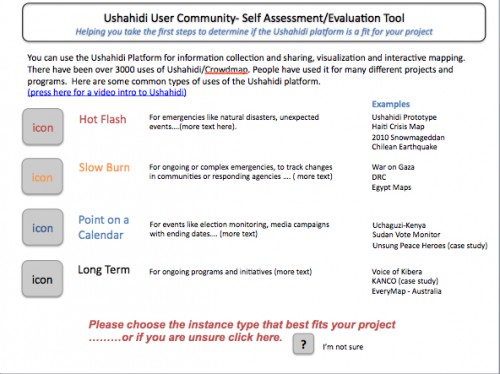[Post written with Jennifer Chan. This post is the second in a series of blog posts documenting a 9-month Ushahidi evaluation project in partnership with the Harvard Humanitarian Initiative supported by the Knight Foundation.]
The Ushahidi-Kenya evaluation is off to a strong start. Since returning from Nairobi in January, 2011 we have worked on the self-evaluation and assessment tool for individuals and organizations interested in using Ushahidi. The purpose of the tool is to help interested organizations learn about the Ushahidi platform via a web-based learning tool and to provide access to community resources and to actively plan their Ushahidi project, through a project cycle. An off-line manual will also be available for those with limited bandwidth. The learning tool has three parts:
 Jennifer is off to Nairobi this week to share our progress and get feedback from the local Ushahidi community.
We are completing our first case study on Unsung Peace Heroes and Building Bridges. These two projects used Ushahidi to map peace related information. Unsung Peace Heroes was designed to recognize individuals who participated in peace efforts in the violent aftermath of the December 2007 Kenyan General Election. These heroes often risked their lives to help members of their community. Building Bridges is an extension of Unsung Peace Heroes. Building Bridges was designed to map peace initiatives throughout Kenya as well as recognize and reward Kenyans who participate in peace initiatives and promote conflict resolution.
These two projects offer interesting lessons for the greater Ushahidi community. Media Focus on Africa Foundation and Butterfly Works, the implementing organizations:
Jennifer is off to Nairobi this week to share our progress and get feedback from the local Ushahidi community.
We are completing our first case study on Unsung Peace Heroes and Building Bridges. These two projects used Ushahidi to map peace related information. Unsung Peace Heroes was designed to recognize individuals who participated in peace efforts in the violent aftermath of the December 2007 Kenyan General Election. These heroes often risked their lives to help members of their community. Building Bridges is an extension of Unsung Peace Heroes. Building Bridges was designed to map peace initiatives throughout Kenya as well as recognize and reward Kenyans who participate in peace initiatives and promote conflict resolution.
These two projects offer interesting lessons for the greater Ushahidi community. Media Focus on Africa Foundation and Butterfly Works, the implementing organizations:
- The assessment module will help new users a) incorporate Ushahidi into project goals and objectives b) plan to collect information that will be mapped, c) identify partnerships and technology resources. This tool may include budget and project timeline templates.
- The implementation module will help users go through setting up the instance and further plan any media/publicity campaigns to help information collection and much more. It is meant to support organizations as they launch and maintain their Ushahidi project.
- The analysis & evaluation module will support users as they actively collect, map and make decisions with their Ushahidi instance. It will also provide tools with which to evaluate the project – helping organizations report their successes and challenges to donors, the user community and others.
 Jennifer is off to Nairobi this week to share our progress and get feedback from the local Ushahidi community.
We are completing our first case study on Unsung Peace Heroes and Building Bridges. These two projects used Ushahidi to map peace related information. Unsung Peace Heroes was designed to recognize individuals who participated in peace efforts in the violent aftermath of the December 2007 Kenyan General Election. These heroes often risked their lives to help members of their community. Building Bridges is an extension of Unsung Peace Heroes. Building Bridges was designed to map peace initiatives throughout Kenya as well as recognize and reward Kenyans who participate in peace initiatives and promote conflict resolution.
These two projects offer interesting lessons for the greater Ushahidi community. Media Focus on Africa Foundation and Butterfly Works, the implementing organizations:
Jennifer is off to Nairobi this week to share our progress and get feedback from the local Ushahidi community.
We are completing our first case study on Unsung Peace Heroes and Building Bridges. These two projects used Ushahidi to map peace related information. Unsung Peace Heroes was designed to recognize individuals who participated in peace efforts in the violent aftermath of the December 2007 Kenyan General Election. These heroes often risked their lives to help members of their community. Building Bridges is an extension of Unsung Peace Heroes. Building Bridges was designed to map peace initiatives throughout Kenya as well as recognize and reward Kenyans who participate in peace initiatives and promote conflict resolution.
These two projects offer interesting lessons for the greater Ushahidi community. Media Focus on Africa Foundation and Butterfly Works, the implementing organizations:
- Relied on strong partnerships with local organizations.
- Used multimedia strategies including radio, television, newspaper and online advertising; interpersonal communication at events throughout Kenya; mobile communication and social media.
- Produced materials in English and Kiswahili.
- Had clear goals and timelines.
- Customized the Ushahidi platform to meet their needs. This was particularly true for Building Bridges as they integrated Ushahidi with Joomla, a free and open source content management system.